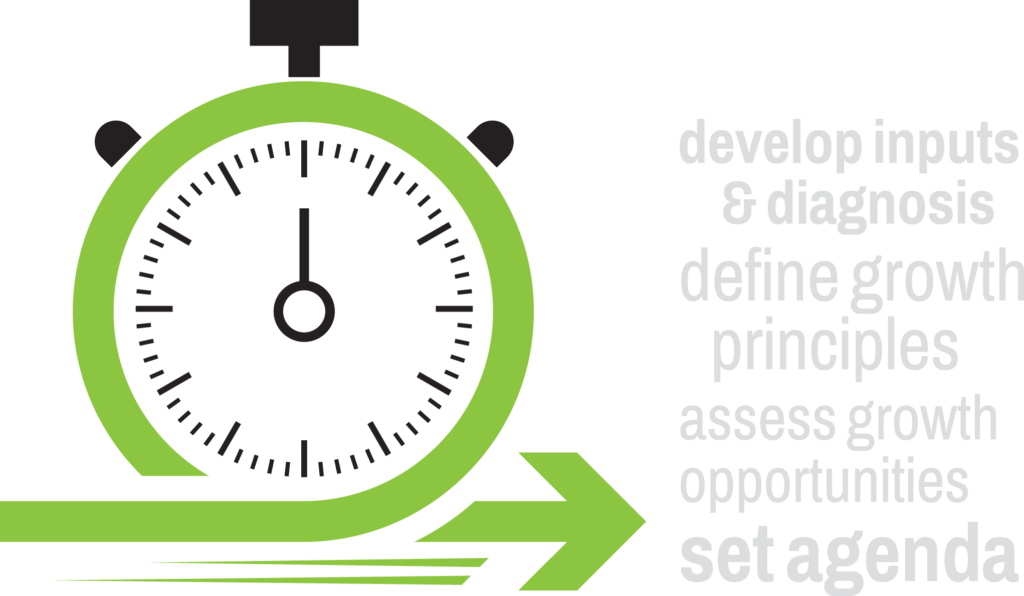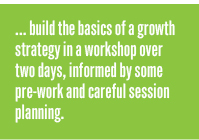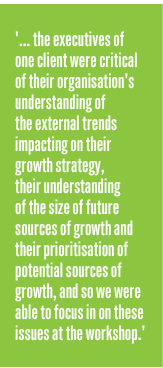How to build a growth strategy in two days
by Dr Marc Levy

Right Thinking
Some organisations are looking for a new way to create growth strategies that is quick and cost effective. We have created a method that enables senior teams to build a compelling growth aspiration, and a targeted portfolio of growth opportunities and implementation plan, in an intensive workshop format. The process is robust and the results have been excellent.
Two days? It’s a provocative title: growth strategy is a serious topic and growth strategies should be built deliberatively. However, organisations can get some of the basics of a growth strategy right with concentrated effort.
 Our full-scale method for helping clients with growth strategy involves: establishing the current underlying growth rate and forecasting the future trajectory; settling on a single growth aspiration among many possible options; valuing the economic contributions of existing and prospective organic and inorganic growth strategies; determining the most value creating combinations of growth strategies; building required capabilities; and creating detailed implementation plans. It requires deep quantitative analysis, fielding an expert team and committing as much as two to three months of work.
Our full-scale method for helping clients with growth strategy involves: establishing the current underlying growth rate and forecasting the future trajectory; settling on a single growth aspiration among many possible options; valuing the economic contributions of existing and prospective organic and inorganic growth strategies; determining the most value creating combinations of growth strategies; building required capabilities; and creating detailed implementation plans. It requires deep quantitative analysis, fielding an expert team and committing as much as two to three months of work.
But many organisations cannot commit the resources required to do this rigorous work, or don’t have the time to do it, so we have developed a simpler method – building the basics of a growth strategy in a workshop over two days, informed by some pre-work and careful session planning.
The preparation: Developing the inputs
It starts by engaging a small project team, usually a couple of senior executives with some external support, to create the inputs for the executive or management team workshop. These inputs may include a diagnosis, a set of growth principles and a way of making sense of the growth opportunities, an initial assessment of the growth opportunities, and the agenda and session plans for the workshop.
Conduct diagnosis
The diagnosis typically includes a presentation of historic and forecast revenue, overall and by component part – product or service line, geography, customer type, etc. – looking back and forward a minimum of three years, and basic industry and market analyses. The industry analysis could cover what’s changing in the world and what that means for the organisation’s growth strategy, or a ‘three-era’ five forces analysis – How attractive was the industry three to five years ago? What’s it like now? What will it be like in three to five years? The purpose of the diagnosis is to create context for the development and evaluation of growth opportunities.
Determine growth principles and a way of framing the growth opportunities
The growth principles cover the project team’s beliefs about growth, such as the organisation’s internal capabilities to manage growth, the capital available to invest in growth, the right number and timing of growth opportunities, and initial high-level hypotheses about the make-up of the growth portfolio. Examples of growth principles are ‘we can successfully prosecute one high effort and two lower effort growth opportunities in FY2018 and FY2019’ or ‘over the next five years, we expect more than two-thirds of the organisation’s growth to come from organic growth’.
We’ve also found that it can be helpful to frame the growth program using a portfolio tool. One such tool is Nagji and Tuff’s Innovation Ambition Matrix (2012), which splits opportunities into three groups: existing products and markets, and new to the company and new to the world products and markets. The three horizons of growth (Baghai, Coley & White 2000) is another helpful tool; it suggests that organisations should simultaneously pursue growth opportunities that defend and extend existing businesses, nurture new businesses and create viable options for the future. A framework from Leinward, Mainardi & Adolph (2016) can help an organisation to identify growth opportunities that build on existing strengths: ‘…start with your own capability-based growth engine … move outward [to, for example, near market expansion] from your core in a deliberate fashion’.
 Conduct initial assessment of growth opportunities
Conduct initial assessment of growth opportunities
In preparation for the workshop, it can be helpful to conduct some basic analysis on known ‘candidate’ growth opportunities – for example, an initiative to sell new services to an existing customer cohort or a highly prospective merger. This analysis might cover market potential; a worst, believable and best case in relation to the value of the opportunity; and an assessment of the organisation’s capability and capacity to pursue the opportunity.
We sometimes help clients to build a simple financial model before the workshop that shows the combined impact of growth opportunities over and above the organisation’s underlying growth trajectory. This can be edited during the workshop as new information comes to hand.
Build the agenda and session plans
Prior to the workshop, we usually conduct a participant survey to identify some of the ‘soft points’ in the existing growth strategy. This helps with development of the agenda. For example, the executives of one client were critical of their organisation’s understanding of the external trends impacting on their growth strategy, their understanding of the size of future sources of growth and their prioritisation of potential sources of growth, and so we were able to focus in on these issues at the workshop.
With or without the survey input, careful and inclusive agenda development and session planning is key. There’s a lot riding on this intensive approach and so it’s important to avoid missteps. Sometimes we plan for the session to run over two non-consecutive days to stage some of the pre-work, find additional data or correct course if necessary. Conducting preliminary analysis privileges growth opportunities known prior to the workshop; splitting the two days helps to ensure proper treatment of new ideas.
The two days: Developing a growth strategy
Confirm growth principles and growth strategy statement
The workshop starts with a review of the growth principles developed by the project team. Will the growth be primarily built on existing or new growth opportunities? Are mergers on or off the table? How much can be invested in the growth program? What capabilities are likely to be required? Are we working alone or with partners?
Another important early step is to develop a concise growth strategy statement (fewer than 35 words), covering the objective of the growth program, its scope or boundary constraints, and what distinctive assets the organisation will employ to deliver growth (Collis & Rukstad 2008).
Long and short listing and creating growth plans
Much of the workshop is then taken up by collaboratively long listing, and then prioritising and short listing, growth opportunities. The purpose of the preparation phase is to give participants the data they need so that they can focus in the workshop on scrutinising and building on the opportunities, and working out which are the most attractive. Attractiveness can be assessed using a simple evaluation tool to plot opportunities based on their potential impact, the timing with which they may be pursued and the effort required to pursue them. The short final list is likely to include six to ten priorities, which require different levels of effort, scheduled over two to three periods.
For the short list of growth opportunities, workshop participants co-create growth plans that cover the activity required, resource allocation, interdependencies and risks, and measures of success. We use the simple financial model referred to above to give workshop participants a level of confidence in the aggregate financial impact of the portfolio of growth opportunities.
 ‘Calling it out’
‘Calling it out’
Throughout the long and short listing process, as groups make important decisions about growth strategy, we try to raise participants’ levels of awareness of cognitive biases that might impact upon the quality of their decision making. We encourage clients to ‘call it out’ when they see colleagues looking for information that supports their existing beliefs, rejecting data that goes against what they believe, or placing too much faith in their own knowledge and opinions. Confirmation bias, overconfidence bias, and others, can be quite easy to recognise: ‘…that didn’t work last time we tried it’, ‘I’m the one who led that, and in my experience…’, ‘All the research shows that retention is easier than acquisition’.
Increasing awareness of biases such as these is particularly important when an organisation is working through growth strategy quickly; there is not the same time for reflection and course correction as there is on a project of longer duration.
What’s next?
Once the final short list, or portfolio of priority growth opportunities, is agreed, participants assign accountabilities, revisit the implications for resource allocation, discuss any enabling infrastructure that is required to support the growth program, and agree measurement, monitoring and review protocols. The governance and organisation of the growth program is critical and it is important that these factors are properly considered. Who will lead the growth effort? Who will meet to review progress? How frequently? What will the standard agenda look like? What reporting is required? How will we handle significant deviations from expectations?
Communications and engagement are important next steps. We typically help clients to create a ‘growth strategy on a page’, to facilitate clarity of internal communications, and encourage clients to make the program as inclusive as possible, including establishing small project teams, with clear accountabilities, to choreograph individual growth opportunities.
***
The results of these ‘cut down’ growth strategy projects have been excellent. In one workshop, levels of agreement to the statement ‘I understand the principles that govern our growth decisions’ went from 30% at the start of the workshop to 100% at the end; ‘I am aware of our growth priorities’ went from 29% to 100% and ‘I understand the firm’s growth plans’ grew from 12% to 100%.
This condensed approach allows organisations to build robust growth strategies quickly and efficiently, so that they can get on with the demanding work of implementation.
References
Baghai, M, Coley, S & White, D 2000, The Alchemy of Growth: Practical Insights for Building the Enduring Enterprise, Perseus Publishing, San Francisco
Collis, D & Rukstad, M 2008, ‘Can you say what your strategy is?’, Harvard Business Review, April
Leinward, P, Mainardi, C & Adolph, G 2016, Growth needs to come from the entire company, viewed 17 June 2017, <https://hbr.org/2016/06/growth-needs-to-come-from-the-entire-company, June 17>
Nagji, B & Tuff, G 2012, ‘Managing your innovation portfolio’, Harvard Business Review, May
© 2017 Right Lane Consulting
We hope the ideas presented here have given you something new to think about. We would love the opportunity to discuss them with you in more detail. Get in touch today.

